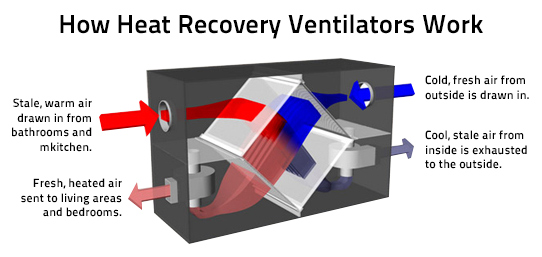How to Pick the Right HRV Unit for Your Living Space
Wiki Article
Exploring the Perks of Heat Recovery Ventilation for Power Effectiveness in Residences
Heat Recovery Ventilation (HRV) systems offer house owners a sensible method to boosting energy performance. By recovering heat from outward bound air, these systems can substantially reduce heating & cooling costs. In addition, they give a constant supply of fresh air, enhancing indoor air top quality and comfort levels. As house owners take into consideration lasting options, comprehending the subtleties of HRV systems becomes significantly crucial. What variables should one assess before making such a financial investment?Comprehending Heat Recovery Ventilation Systems

Just How HRV Enhances Indoor Air Top Quality

Power Cost Savings: The Monetary Benefits of HRV
Making the most of power efficiency, heat recovery ventilation (HRV) systems supply substantial monetary benefits for homeowners. By recouping and reusing warm from exhaust air, HRVs considerably decrease home heating and cooling costs. This modern technology can bring about power savings of dig this approximately 30%, relying on environment and use patterns. Property owners commonly see minimized energy bills quickly after installment, making HRVs a monetarily sensible investment in time. In addition, lots of areas supply incentives or refunds for energy-efficient upgrades, even more boosting the monetary appeal. As power costs continue to rise, the cost-effectiveness of HRVs becomes significantly clear. Generally, the incorporation of HRV systems not just advertises energy performance yet additionally adds to long-lasting financial cost savings for homes.The Ecological Effect of Heat Recovery Ventilation
A substantial ecological benefit of heat recovery ventilation (HRV) systems depends on their capability to reduce general power usage. By reclaiming warm from exhaust air and moving it to incoming fresh air, site web HRV systems reduce the demand for energy-intensive home heating and cooling down techniques. This reduction in energy demand adds to decrease greenhouse gas exhausts, as less nonrenewable fuel source is required to maintain comfortable interior temperatures. In addition, HRV systems enhance indoor air top quality by effectively exchanging stale air with fresh outdoor air, decreasing reliance on mechanical air conditioning systems that can damage the setting. Generally, the application of HRV systems sustains sustainable living practices and straightens with international initiatives to combat climate change by advertising energy effectiveness in household setups.
Choosing the Right HRV System for Your Home
Just how can house owners ensure they choose the right heat recovery ventilation (HRV) system for their needs? First, they ought to examine their home's size and layout, as these factors influence airflow needs. Next, examining the system's effectiveness scores is important, as higher rankings suggest far better efficiency and power cost savings. House owners must likewise consider installation and maintenance expenses, comparing various brands and designs for value. Additionally, it's essential to evaluate noise degrees, as some systems operate even more silently than others. Consulting with a/c experts can supply tailored referrals based on details home conditions. Checking out user evaluations and warranties can help in making a notified decision, ensuring that the selected HRV system efficiently improves interior air top quality and power performance.Often Asked Inquiries

How Often Should I Tidy or Preserve My HRV System?
The regularity of cleansing or preserving a warmth recovery ventilation (HRV) system typically depends on usage and ecological factors. Normally, it is suggested to execute maintenance every 6 months to assure peak performance and air quality.
Can HRV Solutions Assist Decrease Moisture Levels Inside Your Home?
HRV systems can effectively decrease interior humidity degrees by exchanging stale, humid air with fresh, drier air from outdoors. HRV Heat Recovery Ventilation. This process helps preserve a well balanced interior setting, enhancing convenience and preventing moisture-related problems
What Is the Life-span of a Typical HRV System?
The life expectancy of a normal heat recovery ventilation (HRV) system differs, typically lasting in between 10 to 15 years. Normal upkeep can extend its effectiveness and functional life, making certain peak performance throughout its usage period.Exist Any Kind Of Noise Worry About HRV Systems?
Noise interest in HRV systems can emerge, specifically from follower procedure. Many modern-day systems are created to reduce sound levels, ensuring they operate quietly while maintaining performance, which resolves prospective disturbances in living environments.Can I Mount an HRV System Myself, or Do I Need a Professional?
The specific contemplated whether to set up the heat recovery ventilation (HRV) system personally or hire a specialist. Usually, while DIY installation is possible, competence warranties correct performance and conformity with regional structure codes, improving system efficiency.Report this wiki page